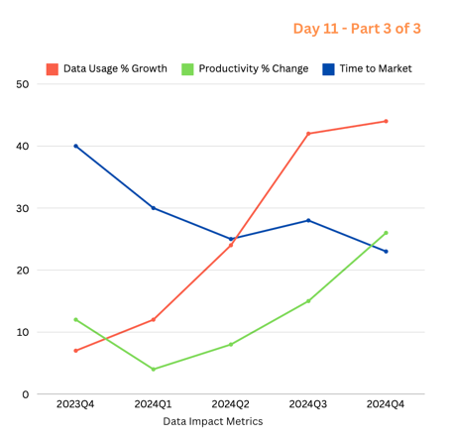
Day 11. Measuring Data Effectiveness and Ensuring Continuous Alignment for AI & GenAI Success. Part 3 of 3.
Welcome back to Day 11 and the final post in our three-part series on the role of data in AI & GenAI success. So far, we’ve discussed building the right data team and managing competing data priorities. Today, we’ll focus on the critical task of measuring the effectiveness of your data strategies and ensuring continuous alignment with your AI and GenAI initiatives. Effective measurement and alignment are essential to maintaining momentum and achieving sustainable success in AI-driven transformation.
1. Defining Key Metrics for Data Effectiveness:
To understand whether your data strategy is driving AI success, you need to define key metrics that measure the effectiveness of your data initiatives. These metrics should align with your organisation’s strategic goals and provide actionable insights into how data supports AI and GenAI efforts.
Action Steps:
- Identify Strategic Metrics: Focus on metrics that directly relate to your AI objectives. For example, if your goal is to enhance customer experience, metrics like customer satisfaction scores, Net Promoter Score (NPS), or customer retention rates may be relevant.
- Measure Data Quality and Usability: Track the quality, completeness, and usability of your data. Metrics such as data accuracy, consistency, and timeliness are critical for assessing how well your data supports AI models and predictions.
- Monitor Data Integration and Accessibility: Ensure data is easily accessible and integrated across departments. Metrics like data latency, integration efficiency, and data sharing frequency can help gauge how seamlessly data flows within your organisation.
2. Ensuring Continuous Alignment with AI & GenAI Objectives:
Aligning your data strategy with AI and GenAI initiatives is not a one-time task; it requires ongoing adjustment and calibration. As your business environment evolves, so too should your approach to data and AI.
Action Steps:
- Establish a Continuous Feedback Loop: Create a feedback mechanism that allows for regular input from all stakeholders involved in AI initiatives. This helps ensure that your data strategy remains aligned with changing business needs and AI objectives.
- Conduct Regular Data Audits: Perform periodic data audits to assess the alignment of your data strategy with your AI goals. This involves reviewing data sources, quality, and relevance to current AI projects and making adjustments as necessary.
- Adapt to Changing Business Priorities: Stay agile by regularly reassessing your data strategy in the context of shifting business priorities and market conditions. Use AI tools to predict future trends and adjust your data strategy to stay ahead of the curve.
3. Overcoming Challenges in Measuring Data Effectiveness:
Measuring data effectiveness is challenging, particularly in large, complex organisations. Leaders often face obstacles such as fragmented data systems, lack of standardised metrics, and organisational silos.
Action Steps:
- Develop Standardised Metrics and Dashboards: Create standardised metrics and dashboards that provide a unified view of data effectiveness across the organisation. This helps in making data-driven decisions and ensures consistency in measurement.
- Break Down Organisational Silos: Foster collaboration between departments to break down silos that impede data sharing and integration. Encourage cross-functional teams to work together on AI projects to improve data flow and utilisation.
- Invest in Data Management Tools: Utilise advanced data management tools like Tableau, Microsoft Power BI, Talend, Informatica, and Alteryx to facilitate data integration, quality control, and analytics. These tools can help automate data audits, track data lineage, and ensure compliance with data governance standards.
4. Understanding Information Flow in Your Organisation:
For AI and GenAI initiatives to succeed, it is crucial to understand how information flows within your organisation. Measuring the flow of data—how it is used, shared, consumed, and managed—has direct impacts on productivity, costs, risks, and organisational behaviour. Tools like GainX can provide insights into these flows, helping you understand where bottlenecks occur and how to optimise data usage.
Action Steps:
- Map Information Flows: Create a comprehensive map of how data moves through your organisation. This includes identifying key data sources, data owners, and points of access. Understand how different departments use and share data.
- Measure Data Touchpoints: Use tools to measure the number and type of touchpoints data has within your organisation. This can help identify where data is duplicated, where it is siloed, and where there are opportunities for greater integration.
- Evaluate Impact on Organisational Behaviour: Assess how data flows impact organisational behaviour. For example, data bottlenecks can lead to frustration and inefficiency, while smooth data flow can enhance collaboration and decision-making.
Specific Examples of What Can Be Measured:
- Data Accessibility: How easily can different teams access the data they need? Measuring data accessibility can highlight potential barriers and help streamline data sharing.
- Data Redundancy: Are there duplicate datasets within different departments? Identifying redundancy can help reduce storage costs and improve data quality.
- Data Usage Frequency: How often is certain data used? Understanding usage patterns can help prioritise data management efforts and ensure that critical data is always available.
- Data Flow Speed: How quickly does data move through the organisation? Measuring the speed of data flow can help identify bottlenecks and areas for improvement.
Why These Measurements Matter:
- Improve Decision-Making: Understanding data flow and usage can help leaders make more informed decisions by ensuring that the right data is available at the right time.
- Enhance Productivity: Optimising data flow reduces bottlenecks and inefficiencies, leading to increased productivity and better utilisation of resources.
- Reduce Costs: A strong data strategy and execution can significantly reduce costs. When processes are more effective, decisions are made faster and smarter, and resources have timely access to critical data, the entire organisation operates more efficiently. This not only cuts down on storage and management costs but also streamlines workflows, reduces operational expenses, and minimises risks. Effective data management ensures that the organisation can focus its resources where they are most needed, avoiding costly delays and redundant efforts.
- Mitigate Risks: By understanding where data bottlenecks occur and addressing them proactively, organisations can mitigate the risk of data breaches, compliance issues, and operational disruptions.
5. Leveraging AI to Enhance Data Strategy and Decision-Making:
AI and GenAI can play a significant role in enhancing your data strategy. By leveraging AI tools, organisations can gain deeper insights, optimise data management, and make more informed decisions.
Action Steps:
- Use AI for Predictive Data Analytics: Implement AI algorithms to predict future data needs and identify potential gaps in your data strategy. This proactive approach can help you stay ahead of data requirements and adjust your strategy accordingly.
- Automate Data Quality Control: Use AI to automate data quality checks and ensure high standards of data integrity. This reduces the burden on data teams and allows them to focus on more strategic tasks.
- Integrate AI for Enhanced Data Governance: Leverage AI to strengthen data governance by monitoring data access, usage, and compliance in real-time. This helps mitigate risks and ensures that data practices align with organisational policies.
- Understand Information Flows: GainX technology can help you map and measure how information flows through your organisation, revealing how data is used, shared, and consumed across departments. This insight enables you to identify areas for optimisation, reduce redundancies, and ensure that critical data reaches the right people at the right time. Understanding these flows directly impacts productivity, costs, risks, and organisational behaviour, making it easier to align AI initiatives with broader business objectives.
Conclusion: Sustaining AI & GenAI Success Through Effective Data Strategies
To sustain success in AI and GenAI initiatives, organisations must measure the effectiveness of their data strategies continuously and ensure alignment with evolving business goals. By implementing robust measurement practices, fostering a data-driven culture, and leveraging AI to enhance data management, leaders can navigate the complexities of AI adoption and drive meaningful business outcomes.
Want to learn more about aligning your data strategy with AI and GenAI goals? Reach out directly on LinkedIn or request a meeting.
Stay tuned for more posts that explore practical steps to drive digital transformation.
#AI #GenAI #DataStrategy #DigitalTransformation #AnthropologyandAI #DecisionIntelligence

